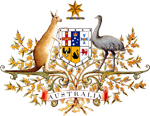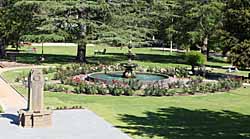
Victory Memoria Gardens, Wagga Wagga, Australia
WAGGAWAGGA.com
Tourism, Travel, & Information Guide to the City of Wagga Wagga in Australia.

|
WAGGAWAGGA.comTourism, Travel, & Information Guide to the City of Wagga Wagga in Australia. |
 |
**** !!!!
BASE-CAMP INTERNATIONAL & WAGGAWAGGA BUSINESS OPPORTUNITY:
!!!! ****
|
|
|
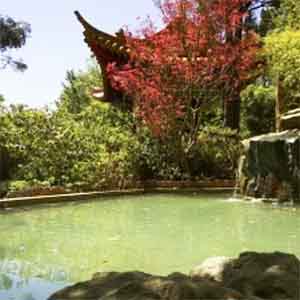 Wagga Wagga Botanic Gardens |
Wagga Wagga, the largest city in the Riverina region of the state of New South Wales, is an excellent stopover for tourists traveling between Sydney and Melbourne by car. This area of New South Wales is also referred to as 'Country NSW' in reference to its rural character.
Lying along the Murrumbidgee river, the city offers tourists a variety of experiences, from museum and gallery hopping to hiking, birdwatching, and wine tasting.
Spend a day or several days exploring the city and the Riverina region. There is plenty to do for the whole family.
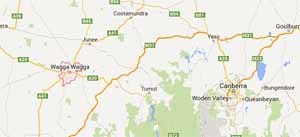
Locals usually omit the second Wagga in referring to the city.
Wagga Wagga is said to mean "The place of many crows" in the language of the Wiradjuri Aboriginal people, although there is some controversy about this interpretation.
Wagga Wagga is mid-way between Sydney and Melbourne, and about 280 miles from each city. It is a 150 mile drive from Canberra.
The 2011 census counted the population of Wagga Wagga as approximately 52,000. In 2014, it was estimated as exceeding 60,000. This includes over 2,500 Aboriginals and Torres Strait Islanders.
Wagga Wagga receives about 22 inches of rain during the year, with July and August being the rainiest months. In the winter months (June - August), average low temperatures are in the upper 30's°F and average high temperatures are in the mid 50's°F. In the summer months, average low temperatures are in the low 60's°F and average high temperatures are in the upper 80's°F.
The Wiradjuri Aboriginal people inhabited the area of Wagga Wagga long before Europeans settled Australia. They lived as hunter-gatherers, eating fish from the river, kangaroos and emus, insects, fruits, and tubers. There is still a sizeable population of Wiradjuri in Wagga Wagga today.
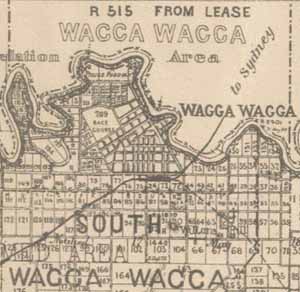 Map of Wagga Wagga in 1897 |
The first European explorer to visit the area was Captain Charles Sturt, who traveled down the Murrumbidgee River in 1829, and passed through what is now the city of Wagga Wagga. Capt. Sturt recruited Wiradjuri men to assist him and his group on this journey.
It wasn't long before European colonists began to settle the area. In 1832, station runs were established on the banks of the Murrumbidgee River by Robert Holt Best and Charles Tompson. Other settlers arrived over the years, squatting on the land, until 1836, when the colonial government established regulations and an annual license fee for land holders.
As the town grew, businesses were established to serve locals and those traveling through the town. The first hotel, the Wagga Wagga Inn, was built in 1846. Major landholders became concerned about criminals on the routes through towns in the area and demanded that local magistrates be designated to enforce laws. In 1847, large landholders, including a member of the Tompson family, were appointed to a local bench of magistrates to enforce the law.
Passage across the Murrumbidgee river was important to the town. In 1862, a bridge was constructed. The bridge was demolished in 1895 due to decay and was replaced with the Hampden Bridge. This bridge was closed in 1995, due to degradation, and replaced with the Wiradjuri Bridge. An additional bridge, the Gobbagombalin Bridge, opened in 1997.
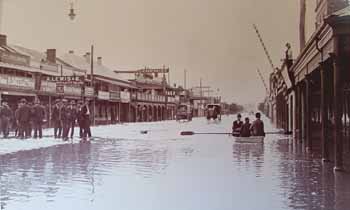 Flooding in Fitzmaurice St., Wagga Wagga 1925 |
The town has been affected by serious flooding over the years. After 11 major floods from the mid-1800's to the mid-1900's, the city constructed a levee designed to protect from 100-year floods. The levee did not protect the north part of the town, and another levee to protect this area was not constructed until 1982.
In 1870, the municipality of Wagga Wagga was established. In 1879, a railway line was extended to Wagga Wagga, which encouraged further growth. The municipality officially became a city in 1946.
During World War I, Wagga Wagga was the starting point for the Kangaroo March, in which recruits would march through New South Wales, recruiting more men to the Australian Imperial Force. In 1927, Victory Memorial Gardens were established to honor World War I soldiers.
In 1940, the Royal Australian Air Force (RAAF) established a base at Forest Hill, just outside the city limits. Today, the RAAF base hosts a training and education center for recruits and the RAAF Waga Heritage Centre, where memorabilia and photographs are on display. The base also displays several aircraft, including the Meteor jet, Canberra bomber, and Sabre fighters.
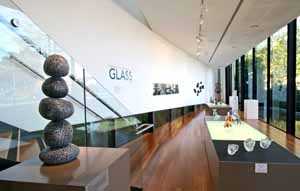 National Art Glass Gallery |
Wagga Wagga provides ample opportunities for enjoying the arts and exploring the history and culture of the region. The Museum of the Riverina displays photographs and memorabilia of events, people, and places important to the Wagga Wagga and the Riverina region. It also hosts touring collections and events, such as film festivals and fashion exchanges. The museum operates two sites, one in the Wagga Wagga Botanic Gardens and the other at the historic city council chambers.
The Wagga Wagga Art Gallery displays contemporary art by local artists. Oil and acrylic paintings, prints, and the National Art Glass Collection inspire tourists and locals alike. Temporary exhibitions feature a variety of art forms, including Aboriginal paintings and political art. The Gallery is centrally located in the Civic Center complex and is open every day of the week except Mondays.
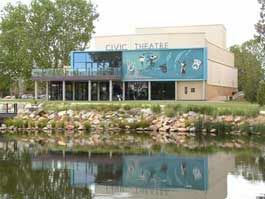 Wagga Wagga Civic Theatre |
Wagga Wagga's Civic Theatre hosts performances ranging from musicals for kids to symphony concerts and ballets by visiting renowned orchestras and troupes.
Situated on the banks of the Wollundry Lagoon, the Civic Theatre holds a 488 seat auditorium, a bar, and an outdoor amphitheater. In addition to performances, the amphitheater is the site of city farmers' markets.
The Civic Theatre was built in 1963 and renovated from the 1970's through the 1990's. It was designed by Stephen J. O'Halloran, a local architect.
Each year in September, the city hosts the Wagga Wagga Jazz and Blues Festival at several venues around town. Local, national, and international jazz and blues bands play at this festival. Organizers and attendees celebrated the event's 20th anniversary in 2014.
Outdoor activities abound in this New South Wales city and countryside.
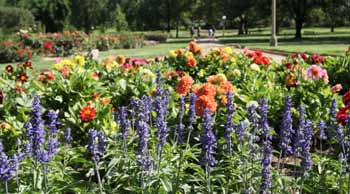 Wagga Wagga Botanic Gardens |
Wagga Wagga Botanic Gardens and Zoo: Spanning over 20 acres, the botanical gardens offer a lush setting for an afternoon stroll, a picnic, or a BBQ. A variety of plant collections, including a Chinese garden, a rose garden, a cactus collection, a tree chapel, a camellia garden, and rainforest gully provide opportunities for hours of exploration. The whole family will enjoy the Waga Zoo and Free Flight Aviary. A Miniature Railway that runs through the woodland area is a treat for kids on the first and third Sundays of each month.
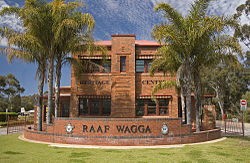 RAAF Wagga Heritage Centre |
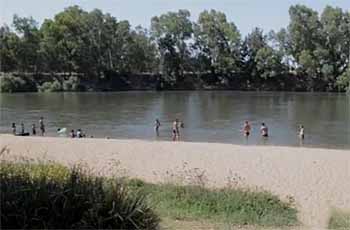 Wagga Wagga beach on Murrumbidgee river |
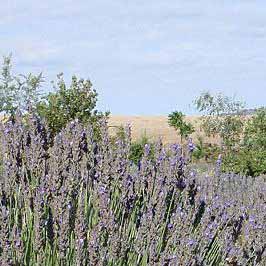 Rustique Lavender Farm |
The Rock Nature Reserve (Kengal Aboriginal Place): The Rock is an outcropping and natural area located 20 miles south of Wagga Wagga, in Lockhart Shire, and offers hiking, rock climbing, and wildlife viewing opportunities. The Rock lookout offers scenic views of the region. It is even possible to view Australia's tallest mountain, Mt. Kosciuszko from here. Picnic areas are also available.
Rustique Lavender Farm: Located 23 miles to the southeast of Wagga Wagga, this working farm offers tourists the opportunity to stroll through fragrant fields, buy lavender-infused products for the home and bath, and meet the resident llamas.
Livingstone National Park and State Conservation Area: With almost 8 square miles of bushland, this natural area 19 miles southwest of Wagga Wagga offers hiking and birdwatching opportunities. Some of the many species that inhabit this protected area are turquoise and Swift parrots, eastern grey kangaroos, swamp wallabies, and wombats.
Information on where to stay in Wagga Wagga is coming soon...
International travelers can fly into Syndey, Melbourne, or Canberra. From there, several options are available to get to Wagga Wagga.
Car rentals are available at downtown and airport locations. Taxis are also readily available. Two bus companies provide service in town, Busabout Wagga Wagga and Wagga Shuttle Bus.
Visit the Koala Reserve in Murrumbidgee National Park |
Advertise On WaggaWagga.comDo you own a business in Wagga Wagga? Grow your business by advertising on Wagga Wagga.com or the rest of the Basecamp International travel network. Contact us today for more information. |
Image Copyright NoteWaggaWagga.com is currently seeking royalty-free images of the city, region, and people of Wagga Wagga for use on this website. Some images on this website have come from other internet sites. The policy of WaggaWagga.com is to attempt to contact the person or organization that owns the copyright to these images to request their permission to use the images. WaggaWagga.com also links to the websites on which images were found. |
